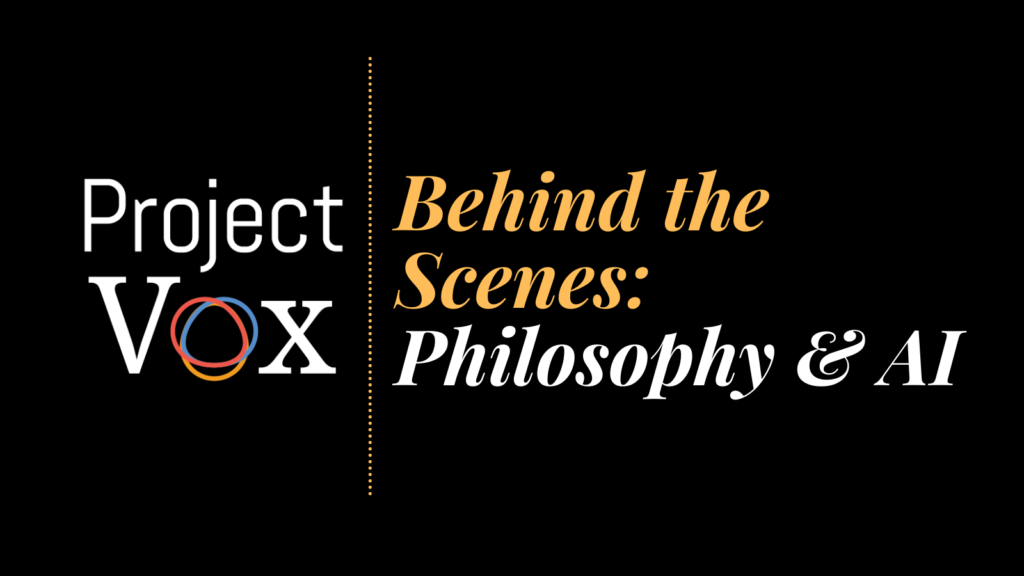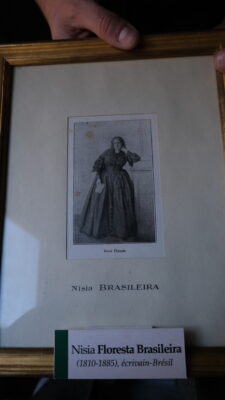What happens when artificial intelligence hallucinates history for which there is very little representation? And might we imagine it differently?
As Project Vox was gearing up to publish the entry on Nísia Floresta this spring, we struggled to find high-resolution images of the nineteenth-century Brazilian philosopher and advocate for indigenous and women’s rights, abolition, and education reform. The image we ended up using to headline the entry, found on Wikipedia Commons, pointed us to its original publication in Mulheres Illustres Do Brazil (1899). The image quality was decent, but we knew little of its history. Did this image, a formal portrait, refer to an engraving? Did that engraving refer to a painting? Even with this image, we needed more images to express the fullness of her life. We heard there may be images located at the Maison d’Auguste Comte in Paris, but they were not available online. We faced publishing the entry before we could figure out how to get them. Fortunately, one of our undergraduate students studying abroad in Paris, Zoë Murphy, offered to visit the Maison d’Auguste Comte and take photographs. We anticipated her upload to our shared Box drive. Suddenly, there Floresta was, a framed engraving held up to a window light. The mark of and vision articulated by the artist is palpable. Notably, the photograph also documents the effort it took to acquire it—a hand holding the frame up to the camera is kept in the frame of the photograph.
During the time that we searched for more images of Floresta, the large-language model Chat GPT-3 by OpenAI and the image generator Stable Diffusion by Stability AI were released.[1] As the Project Manager for Project Vox, I was well-aware of our desperation to find images of Floresta. I thought, maybe AI can render something that gives us clues to a source image? I opened the Stable Diffusion extension in Photoshop and typed “Nísia Floresta Brasileira Augusta.”
Once again, there she was, a miraculous appearance from an obscured archive. But, this time, by “she” I mean a generic, ethnically ambiguous, and airbrushed unnamed woman appearing on the screen.
What the AI reflected to me was what we at Project Vox already knew—the image archive of Floresta is lacking. In fact, there was no pixelated reference to the few images that do exist on the internet, snapshots of which Stability Diffusion is trained from.[2] [3] In the absence of an image of Floresta, the image model generated the most basic image of a woman with a name likely signaled by “Woman” and “Brazilian.” The void of Floresta’s absence is filled by AI’s best prediction, a historically inaccurate, but perhaps marketable, portrait that qualifies as what has come to be known as a “hallucination” in the AI world.
There are what we might think of as hallucinated histories in the non-AI world, especially in representing people and ideas marginalized over the course of time. As one example, a portrait of Isabel Gondim, another nineteenth-century Brazilian writer, apparently was once commonly misidentified as Nísia Floresta.[4] We were able to identify this error during our images research, but we are not always immune. After the publication on English philosopher Anne Conway, we realized we misidentified a painting by Samuel Dirksz van Hoogstraten as definitively of Conway. Upon further research, the most we can verify of the figure is that she is a “woman reading a letter.” The fact is hallucinated history is easy when it is difficult to fact-check the work. Though, unlike AI, it must be noted that these hallucinations are of identifications and associations, not fully generated content.
Saidiya Hartman’s “Venus in Two Acts” (2008) questions methodologies that represent the lives of those erased and violated using archives that index and reproduce the act of erasure and violence. Working with archives from the transatlantic slave trade, Hartman writes,
The archive of slavery rests upon a founding violence. This violence determines, regulates and organizes the kinds of statements that can be made about slavery and as well it creates subjects and objects of power. (10)
Hartman shows us the limits and inevitable failure of the archive in representing the fullness of those enslaved, arguing that the representation is confined to that by the powers that enslaved them. She fears that by reopening this archive of violence, she reproduces it for the living who look in and for the dead who already suffered from it, asking, “Why subject the dead to new dangers and a second order of violence?” (5).
I think Hartman’s question applies to any work that resurrects marginalized figures, even the relatively privileged figures of Project Vox. I return to the photograph of the engraving of Nísia Floresta from the Maison d’Auguste Comte, and the hand that holds the frame to the light. The hand documents not just any special effort, but the effort it takes to lift voices up from the weight of the Western, patriarchal canon. A weight that I am reminded of when I look at it.
In her research for Lose Your Mother (2006), Hartman found reference to a girl called Venus aboard the slave ship Recovery, about whom she feared there was inadequate information to explore thoroughly. She chose not to write much of her, “…I feared what I might invent, and it would have been a romance” and she didn’t want to “[trespass] the boundaries of the archive” (8–9).
But after publication of Lose Your Mother, Hartman writes that she had to confront her own longing to represent Venus beyond the limit of the archive. In recognizing this longing, she began to question her reserved methodology.
The romance of resistance that I failed to narrate and the event of love that I refused to describe raise important questions regarding what it means to think historically about matters still contested in the present and about life eradicated by the protocols of intellectual disciplines. What is required to imagine a free state or to tell an impossible story? (10)
This reflection, writes Hartman, is Venus’s second act, and with her, Hartman proposes another possibility. Instead of ignoring stories because of too little information or reproducing the violence of the archive, Hartman proposes to imagine what could have been. This practice, which she calls “critical fabulation,” is rigorous. It is to scour the archives for every extant bit of information and then imagine the potential of what is known and what can be presumed. In her recent book, Wayward Lives: Beautiful Experiments (2019), Hartman renders the lives of “ordinary” Black women in Philadelphia and New York in the early twentieth century. As Keeanga-Yamahtta Taylor describes in her review, “Hartman’s book is, in part, a critique of the mono-dimensional and flat portrayals of Black women and girls as ‘social documents and statistical persons’…”.[5] The continuity of Hartman’s sentences informed by discrete, known information describes the potential in the gaps of what is unverifiable.
What can an AI do with fragments and voids? Or better yet, how might we imagine an AI programmed to recognize powers that fragment and render absences in its data? And can we imagine an AI that imagines what could have been?
And now, after posing this question, I feel I must pause and confront why I desire this possibility. I question whether this desire comes from an inner longing of inclusion and equality. An inevitably failed project that in the end craves recognition, verifiability, and historicity. But before I leave this idea, I reflect with one more account of the entry on Floresta.
Nísia Floresta was a friend and frequent pen pal to French philosopher Auguste Comte.[6] When we were having difficulty finding portraits of Floresta, we ideated that we could use some portraits of her peers. During a Project Vox meeting, I brought up an image of Comte on our room’s large monitor, and the precision of the image winded the room. The difference in perceived importance reflected in the quality of rendering of the philosopher.
This difference in rendering cannot be made up by methodologies of equality. The information simply is not there. The question is, what do we as scholars and what does the emerging technology of artificial intelligence do in its absence?
References
Hartman, Saidiya. 2008. Lose Your Mother: A Journey along the Atlantic Slave Route. 1. paperback edition. New York: Farrar, Straus & Giroux.
Hartman, Saidiya. 2008. “Venus in Two Acts.” Small Axe: A Caribbean Journal of Criticism 12 (2): 1–14.
Hartman, Saidiya. 2020. Wayward Lives, Beautiful Experiments: Intimate Histories of Riotous Black Girls, Troublesome Women, and Queer Radicals. First published as a Norton paperback. New York, NY: W.W. Norton & Company.
Taylor, Keeanga-Yamahtta. “Saidiya Hartman’s ‘Beautiful Experiments.’” 2019. Los Angeles Review of Books. May 5, 2019. https://lareviewofbooks.org/article/saidiya-hartmans-beautiful-experiments/.
[1] Over the course of 2 months, OpenAI became the fastest growing individual user account in the history of the internet, demonstrating the cultural ingression of AI. https://time.com/6253615/chatgpt-fastest-growing/
[2] Soon, AI’s ingression of the internet will undoubtedly call into question the historicity of many, even contemporary, events. It is speculated that large datasets of the pre-AI internet will significantly increase in value. https://www.nytimes.com/2023/06/30/podcasts/hard-fork-ai-poison.html?smid=url-share
[3] Stability Diffusion is trained using data from non-profit dataset training organization Laion, which is funded in part by Stability Diffusion. https://laion.ai/blog/laion-stable-horde/
[4] https://commons.wikimedia.org/wiki/File:Isabel_Gondim.jpg
[5] https://lareviewofbooks.org/article/saidiya-hartmans-beautiful-experiments/
[6] Even now as I write the two names in a sentence, “Nísia” triggers a red underline in my Microsoft Word processor, while “Auguste Comte” does not, though “Comte” is clearly a non-English word; Microsoft recognizes the influence of one philosopher and continues to question the role of the other.
Kelsey Brod is a multimedia artist, writer, technofeminist, and PhD candidate in Duke’s Computational Media, Arts and Cultures program. Her/their dissertation works to reframe the aesthetics, formulation, and measure of computational performance. Kelsey was the project manager for the 2022 Story+ visualization project and the team project manager from 2022–2023.



